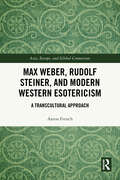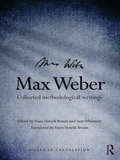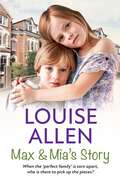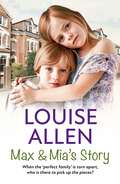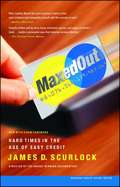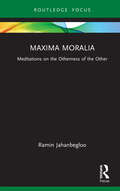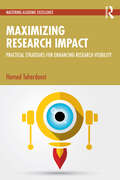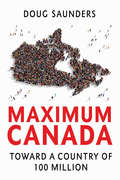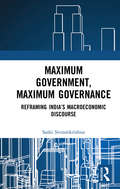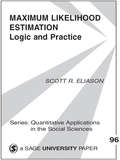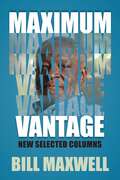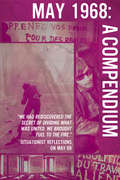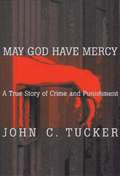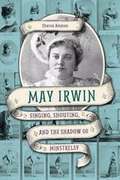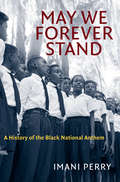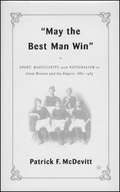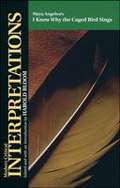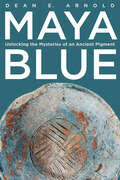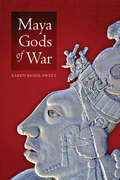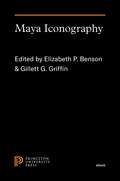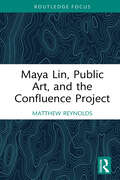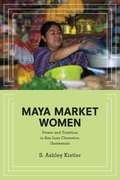- Table View
- List View
Max Weber, Rudolf Steiner, and Modern Western Esotericism: A Transcultural Approach (Asia, Europe, and Global Connections)
by Aaron FrenchThis book challenges previous definitions of modernity by comparing Max Weber (1864–1920), often considered the most important sociologist of the 20th century, and Rudolf Steiner (1861–1925), founder of Waldorfpädagogik and the esoteric social reform movement of anthroposophy.While acknowledging that Weber and Steiner were different in several respects, this research illustrates that the individual histories of these two thinkers are more entangled than previously recognized. This includes the influence of esotericism on their thinking, as well as their profound concern with science and technological change and an openness to the religious and philosophical concepts of the civilizations of South and East Asia.Demonstrating the importance of non-European influences for a full understanding of modernity, this book will be a valuable resource for students and scholars of Asian and European philosophy, social theory, and Asian society.
Max Weber: Collected Methodological Writings (Weber in Translation)
by Sam Whimster Hans Henrik BruunWeber’s methodological writings form the bedrock of key ideas across the social sciences. His discussion of value freedom and value commitment, causality, understanding and explanation, theory building and ideal types have been of fundamental importance, and their impact remains undiminished today. These ideas influence the current research practice of sociologists, historians, economists and political scientists and are central to debates in the philosophy of social science. But, until now, Weber's extensive writings on methodology have lacked a comprehensive publication. Edited by two of the world's leading Weber scholars, Collected Methodological Writings will provide a completely new, accurate and reliable translation of Weber’s extensive output, including previously untranslated letters. Accompanying editorial commentary explains the context of, and interconnections between, all these writings, and additional useful features include a glossary of German terms and an English key, endnotes, bibliography, and person and subject indexes.
Max Weber: Selections in translation
by W. G. RuncimanIn this volume, Mr Runciman has selected extracts, from Max Weber's writings which reflect the full range of his major concerns: the nature of domination in human society, the role of ideas in history, the social determinants of religion, the origin and impact of industrial capitalism and the scope and limits of social science itself. He has also included some shorter extracts from Weber's less familiar writings on such diverse topics as the stock exchange and the history of the piano.
Max and Mia's Story (Thrown Away Children Ser.)
by Louise AllenFrom the bestselling author of the Thrown Away Children series comes another heartbreaking story of life in foster care.Parents Angelina and Ben exist in enviable luxury: not just wealth, success and a gorgeous home, but a loving relationship and beautiful twin babies to complete the perfect family.But having it all means that you have the most to lose. And when cracks begin to appear things fall apart at a shocking pace; and it's twins Max and Mia who suffer the most.Money isn't enough to paper over the problems in this extraordinary and heartbreaking story. It is a foster-caring experience like no other, and one which tests Louise's emotional strength to the core.
Max and Mia's Story (Thrown Away Children Ser.)
by Louise AllenFrom the bestselling author of the Thrown Away Children series comes another heartbreaking story of life in foster care.Parents Angelina and Ben exist in enviable luxury: not just wealth, success and a gorgeous home, but a loving relationship and beautiful twin babies to complete the perfect family.But having it all means that you have the most to lose. And when cracks begin to appear things fall apart at a shocking pace; and it's twins Max and Mia who suffer the most.Money isn't enough to paper over the problems in this extraordinary and heartbreaking story. It is a foster-caring experience like no other, and one which tests Louise's emotional strength to the core.
Max and Mia's Story (Thrown Away Children Ser.)
by Louise AllenFrom the bestselling author of the Thrown Away Children series comes another heartbreaking story of life in foster care.Parents Angelina and Ben exist in enviable luxury: not just wealth, success and a gorgeous home, but a loving relationship and beautiful twin babies to complete the perfect family.But having it all means that you have the most to lose. And when cracks begin to appear things fall apart at a shocking pace; and it's twins Max and Mia who suffer the most.Money isn't enough to paper over the problems in this extraordinary and heartbreaking story. It is a foster-caring experience like no other, and one which tests Louise's emotional strength to the core.
Maxed Out
by James D. ScurlockForeclosures are hitting record highs; Americans are declaring bankruptcy at rates ten times that during the great Depression; more college students drop out because of debts than due to poor grades; reports of debtor suicides proliferate in the media. In other words, it's a great time to be in the banking business. Maxed Out takes us on a road trip that is sometimes hysterical and often horrifying: from Las Vegas to the Bible Belt, from the backwoods to inner cities, where the world's largest financial giants troll for their next victims. Welcome to a country populated by debt pirates, corporate predators, human credit card billboards, debt evangelists, megamillion-dollar spec homes, and, of course, trillions of dollars of easy credit. Combining startling facts with even more startling examinations of individuals, institutions, the government, and modern religion, James Scurlock separates the myths (there is "good debt" and "bad debt") from the harsh reality (corporations partner with colleges to target today's youth; credit reports are riddled with errors that will never be fixed; and death, for many of those in trouble, is the only way out). At a time when the financial industry posts ever-higher profits even as its clients drown in the flood of easy credit, Scurlock exposes very real, potentially disastrous systems and policies that are consuming millions of Americans. Maxed Out takes readers on a wickedly smart and entertaining tour of what one interviewee calls "the last taboo."
Maxima Moralia: Meditations on the Otherness of the Other
by Ramin JahanbeglooThis book highlights the problem of one-dimensional, reductionistic life of the modern individual. An expression of crisis in our world, it discusses the imperative need to have a more comprehensive, non-reductionist life where the Other is incorporated, especially the relationship between the Other and the Self, based on virtues like love, empathy, equality, and compassion. The volume sheds light on how the world has forgone the art of living for a mutilated sense of well-being, the rise of conformity and complacency in human thought, and the lack of democratic dissent and citizenry responsibility in our contemporary societies, which is now characterized by mass immaturity, propelled by a process of thoughtlessness. It discusses how humans need to be aware of the life they lead, to think about Otherness of the Other not just as another virtue but also as a crucial element in the survival of humanity, for people to coexist with the world around them as equals. Furthermore, it advocates meaningful and thoughtful existence, in touch with the Nature we coexist with, to ensure that humanity is not robbed of its noble spirit as we live to survive in our techno-capitalist societies. An introspective read, this book will be of great interest to scholars and researchers of moral and ethical philosophy, political philosophy, and political science.
Maximizing Research Impact: Practical Strategies for Enhancing Research Visibility (Mastering Academic Excellence)
by Hamed TaherdoostMaximizing Research Impact: Practical Strategies for Enhancing Research Visibility offers a comprehensive guide for researchers, academics, and practitioners across disciplines who wish to increase the visibility, accessibility, and influence of their research outputs.This book addresses the challenges and opportunities presented by the rapidly evolving research landscape, including the rise of digital platforms, open access publishing, and the importance of interdisciplinary collaboration. It provides actionable strategies to navigate these changes effectively and ensure that research is not only published but also widely disseminated, recognized, and utilized.Designed for a diverse audience, this will be suitable for early-career researchers, established scholars, and graduate students seeking to build or enhance their academic presence. It will also be useful for research administrators and managers looking to support and promote research within institutions, as well as interdisciplinary and collaborative researchers aiming to navigate and leverage diverse networks. Additionally, the book offers insights for science communicators and media professionals involved in disseminating research to the public.
Maximum Canada: Why 35 Million Canadians Are Not Enough
by Doug SaundersTo face the future, Canada needs more Canadians. But why and how many? Canada’s population has always grown slowly, when it has grown at all. That wasn’t by accident. For centuries before Confederation and a century after, colonial economic policies and an inward-facing world view isolated this country, attracting few of the people and building few of the institutions needed to sustain a sovereign nation. In fact, during most years before 1967, a greater number of people fled Canada than immigrated to it. Canada’s growth has faltered and left us underpopulated ever since. At Canada’s 150th anniversary, a more open, pluralist and international vision has largely overturned that colonial mindset and become consensus across the country and its major political parties. But that consensus is ever fragile. Our small population continues to hamper our competitive clout, our ability to act independently in an increasingly unstable world, and our capacity to build the resources we need to make our future viable. In Maximum Canada, a bold and detailed vision for Canada’s future, award-winning author and Globe and Mail columnist Doug Saunders proposes a most audacious way forward: to avoid global obscurity and create lasting prosperity, to build equality and reconciliation of indigenous and regional divides, and to ensure economic and ecological sustainability, Canada needs to triple its population.
Maximum Government, Maximum Governance: Reframing India’s Macroeconomic Discourse
by Sashi SivramkrishnaAusterity, fiscal consolidation, fiscal discipline and fiscal deficit targets have become the buzzwords of contemporary macroeconomic policy. By tracing the history of macroeconomic schools of thought, Maximum Government, Maximum Governance explores the origins, essence, shortcomings and deception of mainstream neoliberal macroeconomics. Arguing that economies are financially constrained, neoliberal macroeconomics dislodged full employment as the target of policy replacing it with a low and stable inflation target. Monetary policy under the control of an independent central bank became the primary instrument to assist free and globalized markets to propel economies towards full employment. However, the global financial crisis of 2008 and rising inequalities of income and wealth in the last decade within and across economies has led to rise of nationalist-populist leaders in many parts of the world. Although neoliberal economics has been put under the scanner by these leaders, their actions seem reactionary and without a coherent understanding of alternative schools of economic thought. An alternative based on sound economic reasoning and institutional realities is required to challenge neoliberal and arbitrary populist policies.Based on an introductory analysis of Modern Money Theory (MMT), this book seeks to present an alternative viewpoint on macroeconomics and macroeconomic policy to address the challenges of economic growth, unemployment and inequality. While adherents of MMT are convinced of its robustness, the challenge is to reframe macroeconomic discourse, which must essentially reject the notion that an economy is financially constrained and instead turn the spotlight on real resource and governance constraints. Please note: Taylor & Francis does not sell or distribute the Hardback in India, Pakistan, Nepal, Bhutan, Bangladesh and Sri Lanka
Maximum Likelihood Estimation: Logic and Practice
by Scott R. EliasonIn this volume the underlying logic and practice of maximum likelihood (ML) estimation is made clear by providing a general modeling framework that utilizes the tools of ML methods. This framework offers readers a flexible modeling strategy since it accommodates cases from the simplest linear models to the most complex nonlinear models that link a system of endogenous and exogenous variables with non-normal distributions. Using examples to illustrate the techniques of finding ML estimators and estimates, Eliason discusses: what properties are desirable in an estimator; basic techniques for finding ML solutions; the general form of the covariance matrix for ML estimates; the sampling distribution of ML estimators; the application of ML in the normal distribution as well as in other useful distributions; and some helpful illustrations of likelihoods.
Maximum Vantage: New Selected Columns
by Bill MaxwellA veteran journalist speaks truth to power on issues that matter to the nation In this collection of columns spanning the years 2000-2019, veteran journalist Bill Maxwell tackles important issues faced by Florida and broader American society that remain as relevant as ever. Demonstrating the courage to take on controversy and the signature pithy style that have won him a nationwide readership, Maxwell offers his opinion on a wide variety of questions with a focus on race, agricultural labor, education, and the environment. Maxwell writes from the vantage point of a Florida native who grew up as a migrant farmworker at the end of the Jim Crow era; a Black man who participated in the civil rights movement to help make the state more equitable; a college professor who lectured about the harms of racial discrimination; and an environmentalist who has lived in the Everglades as artist-in-residence. Grounding his social criticism in firsthand knowledge of the contradictions of life in the American South, Maxwell uses reason and research to highlight uncomfortable realities and injustices that persist in the twenty-first century.Believing that informed citizens will make decisions that positively impact society, Maxwell prompts readers to examine their own perspectives, question their assumptions, and come to a deeper understanding of their state and nation. Publication of this work made possible by a Sustaining the Humanities through the American Rescue Plan grant from the National Endowment for the Humanities.
May 68' - A Compendium: Situationist reflections on the uprisings in France, May 1968
by Mustapha Khayati Rene Vienet Rene RieselAs the 50th anniversary of the events of May 68’ passes, it leaves a familiar, image heavy trail in it’s wake - young street fighting Parisians, earnest but chic looking Sorbonne occupiers, the iconic graffiti /posters : imagery all long since passed into the mythology of pop culture, endlessly recycled and recuperated, stripped bare of real political legacy. Within that mythology, the role of the Situationists has long been contested: underplayed exaggerated, misunderstood. This compendium reprints crucial pieces written by the Situs themselves, helping show May 68’ as a reaction to a profound systemic stasis running deep through mid 20th C capitalism, and to the autocratic, hierarchical, and tradition-bound ruling class that still oversaw it in France. "On the Poverty of Student Life”(1966) was originally printed via appropriated funds when 5 pro Situs were elected to Strasbourg Uni Student Union. It’s searing critique of what the authors considered the miserable, passive consumerism of the modern hipster student was a powerful portent of what was to come: “The real poverty of his everyday life finds its immediate phantastic compensation in the opium of cultural commodities... he is obliged to discover modern culture as an admiring spectator... he thinks he is avant-garde if he's seen the latest Godard or 'participated' in the latest 'happening'. He discovers modernity as fast as the market can provide it:” Possibly the single most important document recording and analysing the events of May 68’ remains “Enragés and Situationists in the Occupations Movement”, written by Rene Vienet, a young pro Situ at the centre of the Sorbonne Occupation. A 60 page, chronological account, at times it unselfconsciously captures the poetry of the revolution they were helping make, but mostly the focus in on the objective, material forces that shaped events after the initial occupation of the Sorbonne. This vital piece is supplemented/supported by contemporaneous ‘Various Documents from May 68’, and retrospective ‘Further Reflections on May 68’ from the Situationist International journal. Slightly more tangentially, ‘Preliminaries on Councils and Councillist Organization’ looks deeper into the proto-revolutionary structures that the Situationists saw at the very core of global post-capitalism in the 20th century, and beyond.
May God Have Mercy
by John C. TuckerIn 1982, in Grundy, Virginia, a young miner named Roger Coleman was sentenced to death for the murder of his sister-in-law. Ten years later, the sentence was carried out, despite the extraordinary efforts of Kitty Behan, a brilliant and dedicated young lawyer who devoted two years of her life to gathering evidence of Coleman's innocence, evidence so compelling that media around the world came to question the verdict. The courts, ruling on technicalities, refused to hear the new evidence and witnesses. Finally, the governor of Virginia ordered a lie-detector test to be administered on the morning of Coleman's scheduled execution, and in a chair that to Coleman surely looked like nothing so much as an electric chair.
May Irwin: Singing, Shouting, and the Shadow of Minstrelsy
by Sharon AmmenMay Irwin reigned as America's queen of comedy and song from the 1880s through the 1920s. A genuine pop culture phenomenon, Irwin conquered the legitimate stage, composed song lyrics, and parlayed her celebrity into success as a cookbook author, suffragette, and real estate mogul. Sharon Ammen's in-depth study traces Irwin's hurly-burly life. Irwin gained fame when, layering aspects of minstrelsy over ragtime, she popularized a racist "Negro song" genre. Ammen examines this forgotten music, the society it both reflected and entertained, and the ways white and black audiences received Irwin's performances. She also delves into Irwin's hands-on management of her image and career, revealing how Irwin carefully built a public persona as a nurturing housewife whose maternal skills and performing acumen reinforced one another. Irwin's act, soaked in racist song and humor, built a fortune she never relinquished. Yet her career's legacy led to a posthumous obscurity as the nation that once adored her evolved and changed.
May We Forever Stand: A History of the Black National Anthem (The John Hope Franklin Series in African American History and Culture)
by Imani PerryThe twin acts of singing and fighting for freedom have been inseparable in African American history. May We Forever Stand tells an essential part of that story. With lyrics penned by James Weldon Johnson and music composed by his brother Rosamond, "Lift Every Voice and Sing" was embraced almost immediately as an anthem that captured the story and the aspirations of black Americans. Since the song's creation, it has been adopted by the NAACP and performed by countless artists in times of both crisis and celebration, cementing its place in African American life up through the present day. In this rich, poignant, and readable work, Imani Perry tells the story of the Black National Anthem as it traveled from South to North, from civil rights to black power, and from countless family reunions to Carnegie Hall and the Oval Office. Drawing on a wide array of sources, Perry uses "Lift Every Voice and Sing" as a window on the powerful ways African Americans have used music and culture to organize, mourn, challenge, and celebrate for more than a century.
May the Best Man Win: Sport, Masculinity, and Nationalism in Great Britain and the Empire, 1880-1935
by Patrick F. McDevittAs Britain's great power status came to be increasingly challenged in the decades before the First World War, one by-product of the resultant uncertainty was the weakening of the Victorian, middle-class consensus of what constituted ideal manhood. Britain's empire was not only the source of wealth and power, but it simultaneously provided alternative models of masculinity and nationhood. Consequently, the empire and the commonwealth played an important role in defining imperial gender relations in both Britain and in the colonies and dominions. May the Best Man Win investigates the continual re-assessment and reassertion of various masculine ideals associated with sport in the British empire between 1880 and 1935.
Maya Angelou's I Know Why the Caged Bird Sings (Modern Critical Interpretations)
by Harold BloomSelected essays on Angelou's book.
Maya Blue: Unlocking the Mysteries of an Ancient Pigment (Path to Open)
by Dean E. ArnoldOne of the great technological achievements of the ancient Maya, Maya Blue is one the world’s most unusual ancient pigments. In Maya Blue, Dean E. Arnold offers a comprehensive history of its study for almost a century, filled with personal anecdotes drawn from his decades of work uncovering the Maya knowledge of its constituents, its ancient sources, and how it was made—including previously unknown methods. The book presents a fresh holistic perspective that documents these discoveries and the scientific process that led to them and provides testable hypotheses about how the pigment and the technology used to make it moved throughout Mesoamerica. Combining the organic dye indigo and the inorganic clay mineral palygorskite in a highly stable chemical hybrid that, unlike indigo, resists attacks by acids, alkalines, and organic solvents and endures without fading, Maya Blue has a rich blue color that has survived for centuries in one of the world’s harshest climates. First used at the site of Calakmul in the tropical forest of southern Mexico during the Late Preclassic period, the Maya’s abiding hue diffused across Mesoamerica over a period of 1,700 years. It appears on Maya pottery, sculpture, murals, and codices and carries multiple meanings, standing as a symbol for cultural cornerstones such as sacrifice and the rain god Chaak. It was discovered in 1931 at Chichén Itzá, and its composition was a mystery for more than three decades, then questions about its source, how and why it achieved such stability, and how and why the Maya made the pigment persisted even longer. In Maya Blue, Arnold summarizes ethnographic, archaeological, chemical, and material science research over the last century from an anthropological perspective. This thorough, engaging, and accessible book chronicles the history of this pigment as no work has done before.
Maya Christians and Their Churches in Sixteenth-Century Belize: Maya Christians And Their Churches In Sixteenth-century Belize (Maya Studies)
by Elizabeth Graham"An important and innovative study that brings a good number of fascinating archaeological findings to bear on the process of Christian conversion in the colonial Maya world. Seldom has the archaeological material culture of an evangelized society been brought to light so thoroughly and engagingly."—Fernando Cervantes, coauthor of Angels, Demons, and the New World"A convincing and fascinating study of Maya religion and Christianity in the frontier."—Joel Palka, University of Illinois-ChicagoBased on her analysis of archaeological evidence from the excavations of Maya churches at Tipu and Lamanai, Elizabeth Graham seeks to understand why the Maya sometimes actively embraced Catholicism during the period of European conquest and continued to worship in this way even after the end of Spanish occupation.The Maya in Belize appear to have continued to bury their dead in Christian churchyards long after the churches themselves had fallen into disuse. They also seem to have hidden pre-Hispanic objects of worship in Christian sacred spaces during times of persecution, and excavations reveal the style of the early churches to be unmistakably Franciscan. The evidence suggests that the Maya remained Christian after 1700, when Spaniards were no longer in control, which challenges the widespread assumption that because Christianity was imposed by force it was never properly assimilated by indigenous peoples.Combining historical and archaeological data with her experience of having been raised as a Roman Catholic, Graham proposes a way of assessing the concept of religious experience and processes of conversion that takes into account the material, visual, sensual, and even olfactory manifestations of the sacred.Elizabeth Graham is senior lecturer of Mesoamerican archaeology at University College London.
Maya Gods of War
by Karen Bassie-SweetNumerous archaeological projects have found substantial evidence of the military nature of Maya society, and warfare is a frequent theme of Maya art. Maya Gods of War investigates the Classic period Maya gods who were associated with weapons of war and the flint and obsidian from which those weapons were made. Author Karen Bassie-Sweet traces the semantic markers used to distinguish flint from other types of stone, surveys various types of Chahk thunderbolt deities and their relationship to flint weapons, and explores the connection between lightning and the ruling elite. Additional chapters review these fire and solar deities and their roles in Maya warfare and examine the nature and manifestations of the Central Mexican thunderbolt god Tlaloc, his incorporation into the Maya pantheon, and his identification with meteors and obsidian weapons. Finally, Bassie-Sweet addresses the characteristics of the deity God L, his role as an obsidian merchant god, and his close association with the ancient land route between the highland Guatemalan obsidian sources and the lowlands. Through analysis of the nature of the Teotihuacán deities and exploration of the ways in which these gods were introduced into the Maya region and incorporated into the Maya worldview, Maya Gods of War offers new insights into the relationship between warfare and religious beliefs in Mesoamerica. This significant work will be of interest to scholars of Maya religion and iconography.
Maya Iconography
by Elizabeth P. Benson Gillett G. GriffinA landmark work on the iconography of one of the world&’s great civilizationsThis book presents foundational work on Maya iconography from leading practitioners in fields ranging from archaeology, anthropology, and art history to linguistics, astronomy, photography, and medicine. The period discussed runs from the last centuries B.C. through the great Maya Classic period, with some discussion of later eras and of regions outside the Maya area. Featuring an incisive introduction by Elizabeth Benson and Gillett Griffin, Maya Iconography demonstrates how Maya beliefs developed over time and makes important connections between Preclassic and Classic iconography.The contributors are John Carlson, Michael Coe, David Freidel, Donald Hales, Norman Hammond, Nicholas Hellmuth, John Justeson, Barbara Kerr, Justin Kerr, Mary Ellen Miller, William Norman, Lee Parsons, Francis Robicsek, Linda Schele, David Stuart, and Karl Taube.
Maya Lin, Public Art, and the Confluence Project (Routledge Focus on Art History and Visual Studies)
by Matthew ReynoldsThe first scholarly monograph devoted exclusively to this vital work of contemporary public art, this book examines Maya Lin’s Confluence Project through the lens of environmental humanities and Indigenous studies. Matthew Reynolds provides a detailed analysis of each earthwork, along with a discussion of the proposed final project at Celilo Falls near The Dalles, Oregon. The book assesses the artist’s longtime engagement with the region of the Pacific Northwest and explores the Confluence Project within Lin’s larger oeuvre. Several consistent themes and experiences are common amongst all the sites. These include an emphasis on individual, multisensory encounters with the earthworks and their surrounding contexts; sound as an experiential dimension of landscape; indexical accounts of the multicultural, multispecies histories of each place; and an evocation of loss. The book will be of interest to scholars working in art history, contemporary art, environmental studies, environmental humanities, and Native American studies.
Maya Market Women: Power and Tradition in San Juan Chamelco, Guatemala (Interpretations of Culture in the New Millennium)
by S. Ashley KistlerAs cultural mediators, Chamelco's market women offer a model of contemporary Q'eqchi' identity grounded in the strength of the Maya historical legacy. Guatemala's Maya communities have faced nearly five hundred years of constant challenges to their culture, from colonial oppression to the instability of violent military dictatorships and the advent of new global technologies. In spite of this history, the people of San Juan Chamelco, Guatemala, have effectively resisted significant changes to their cultural identities. Chamelco residents embrace new technologies, ideas, and resources to strengthen their indigenous identities and maintain Maya practice in the 21st century, a resilience that sets Chamelco apart from other Maya towns. Unlike the region's other indigenous women, Chamelco's Q'eqchi' market women achieve both prominence and visibility as vendors, dominating social domains from religion to local politics. These women honor their families' legacies through continuation of the inherited, high-status marketing trade. In Maya Market Women, S. Ashley Kistler describes how market women gain social standing as mediators of sometimes conflicting realities, harnessing the forces of global capitalism to revitalize Chamelco's indigenous identity. Working at the intersections of globalization, kinship, gender, and memory, Kistler presents a firsthand look at Maya markets as a domain in which the values of capitalism and indigenous communities meet.
